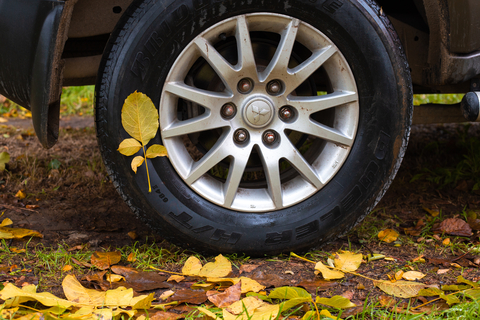5 Reasons to Check Your Tires This Month

Tires don’t get much attention until something goes wrong–like sliding through an intersection during a heavy February storm.
Yet, a few moments of attention can help prevent disaster. After all, tires are one of your vehicle's most important safety components.
“You should perform a visual inspection every month to identify any wear problems,” said Dan Zielinski, senior vice president of public affairs for the Rubber Manufacturers Association. “Inspect tires for cuts, scrapes and odd wear patterns, and make sure they are properly inflated.”
Checking your tire’s air pressure is a great place to start, Zielinski said. The owner’s manual tells what the recommended air pressure is, as does a sticker on the inside of the driver’s side door. Underinflated tires increase friction with the road and lower fuel economy, while overinflated tires generate heat that can damage.
Tire tread offers an early warning sign for other maintenance issues. Bald spots may indicate an unbalanced wheel. Wear along the center of the tire may indicate an overinflated tire or poor alignment.
Tire rotation can’t correct wear problems due to worn mechanical parts or incorrect inflation pressures, Zielinski said. Yet, it does promote even wear and maximizes tire lifespan.
“Get a rotation whenever you change the oil, or roughly every 5,000 miles,” Zielinski said.
Don’t forget to check the spare tire. Temporary tires aren’t built as sturdily as the standard tires, Zielinski said. They don’t have steel belts, and they don’t have the same durability and speed capability of a full-sized tire.
“They are only meant to be used in emergency situations to get you to an automotive repair shop or tire dealer to have a damaged tire repaired or replaced,” he said. “They’re a good stopgap measure for a short time but it won’t be of any use if it’s flat.”
Zielinski offers the following suggestions for checking your tires after a long winter.
- Tread depth. When the wear marks show, it’s time for new rubber. If you’re not sure about tread depth, use a depth gauge to measure how much tread is left.
- Take the “penny test” to read the amount of tread depth left in your tire. Insert a penny with Lincoln’s head pointing down into the tire tread. If you can see any of Lincoln’s head, then it is time to replace your tires.
- Regular tire rotation. Rotating tires on a regular basis prevents uneven wear. For vehicles with tires all the same size, rotate from front to back and side to side to maintain even tread wear. See your vehicle maintenance manual for rotation mileage intervals.
- Tire pressure: Make sure your tires are properly inflated. Check tires when they are cold to get the most accurate reading.
“Tires are engineered to handle a lot of stress as long as they are maintained properly,” Zielinski said. “Once the integrity of components is damaged, tires are at much greater risk of failure.”